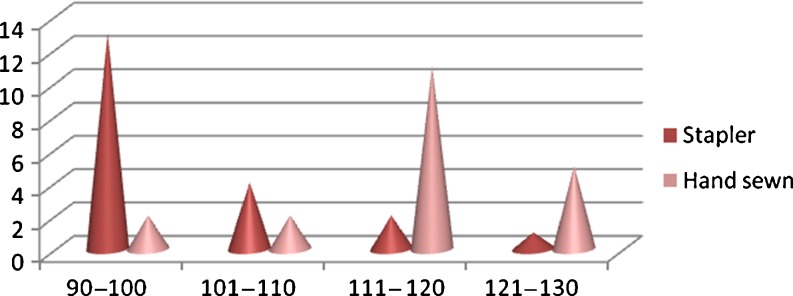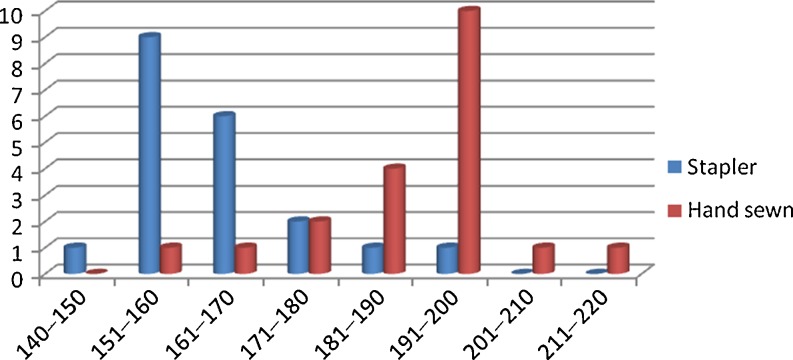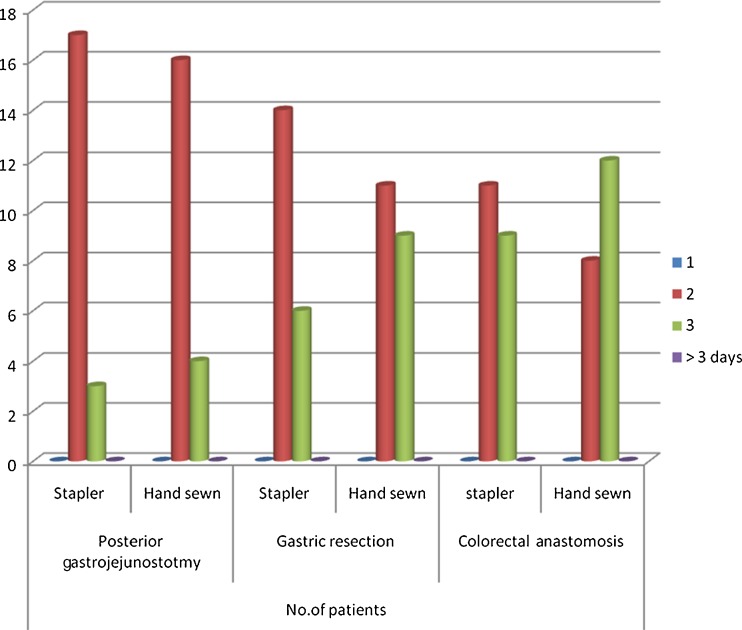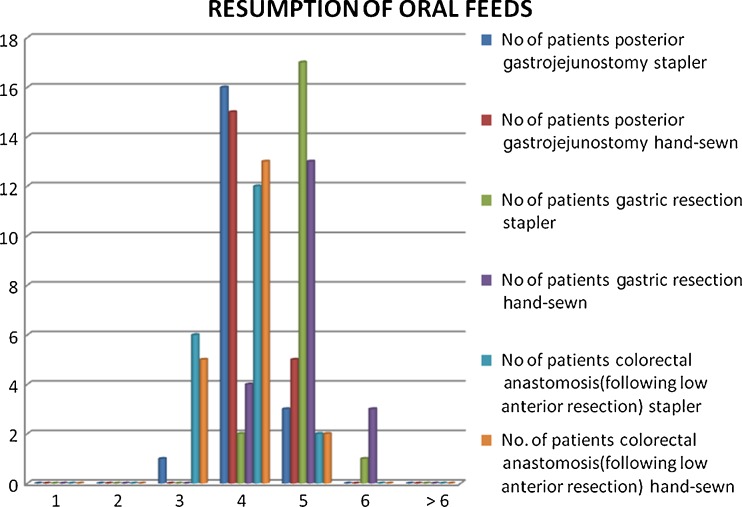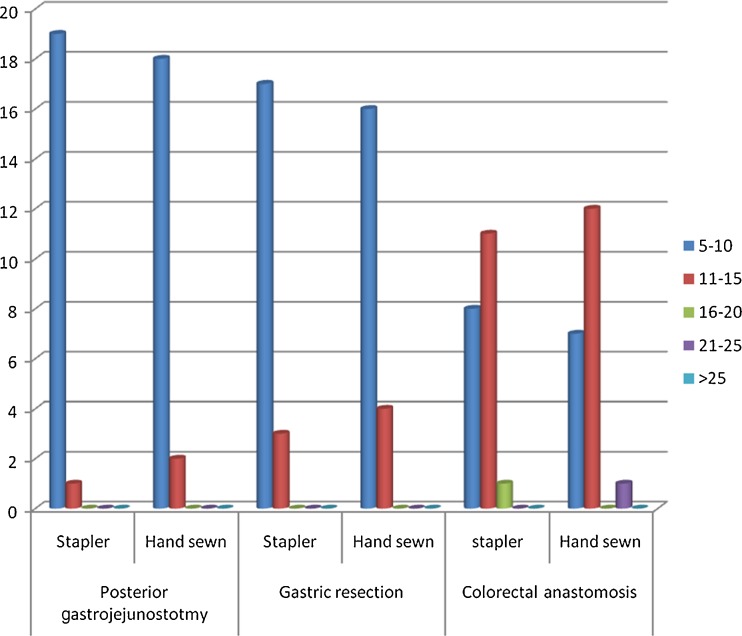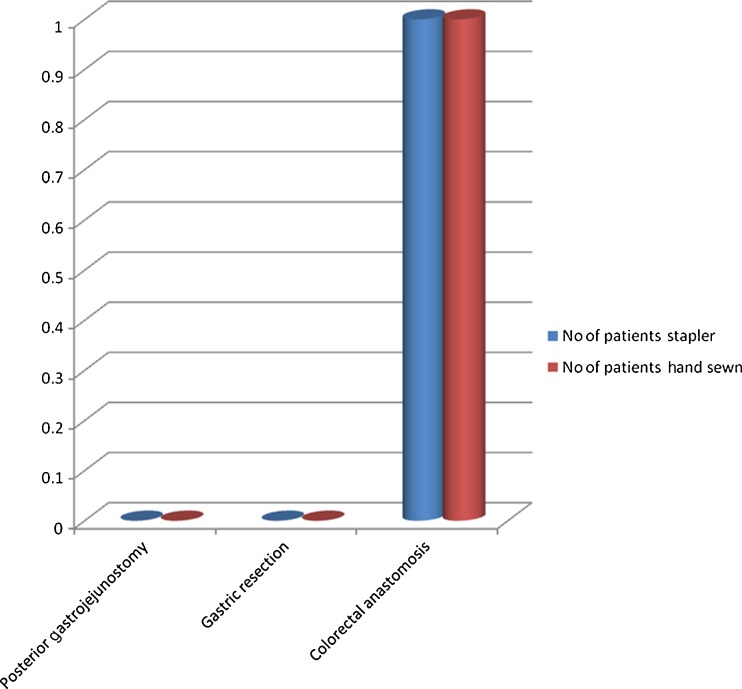Abstract
Conventional (hand-sewn) technique of intestinal anastomosis has been in vogue for decades. Staplers which were developed to simplify surgery began to have significant impact. To compare staplers versus conventional anastomosis with respect to certain intra operative and post operative parameters. Prospective study from November 2008 to October 2010 in Hyderabad at OSMANIA, GANDHI, MNJ CANCER hospitals. 120 patients were divided into three groups of 40 each, depending on the surgery like posterior gastrojejunostomy, distal gastrectomy and reconstruction (Billroth II) and colorectal anastomosis. Of these 40 patients, 20 were in hand-sewn group and the other 20 in stapler group. Unpaired ‘t’ test was used to find ‘p’ value . ‘p’ value less than 0.05 was considered statistically significant. Total operating time was shortened in stapler group. No significant difference was found in terms of restoration of intestinal function, post-operative hospital stay, post-operative complications like anastomotic leak. Staplers can expedite surgery. They have better access to difficult—to—reach areas. Thus staplers can be beneficial though one should not forget the art of conventional suturing.
Keywords: Intestinal anastomosis, Hand-sewn, Linear staplers, Circular staplers
Introduction
For fashioning anastomosis, the factors considered are time required, restoration of function, effective hemostasis, reduction of tissue trauma, and prevention of postoperative morbidity; for example, leak (sepsis). Accurate approximation without tension and with a good blood supply is fundamental whether suturing or stapling [1, 2]. Staplers have been developed to fulfill most of these criteria.
Staplers are capable of cutting and stapling at the same time avoiding the need for clamping [2, 3]. The increased cost of staplers is offset by reduction in operating time [1]. Circular staplers have better access in low pelvic surgery, sparing many patients from permanent colostomy [2, 4]. Anastomosis can be done by suturing or stapling. Accordingly, it is worthwhile to study the two approaches to bowel anastomosis.
Materials and Methods
Prospective study from November 2008 to October 2010 in Hyderabad at OSMANIA, GANDHI, MNJ CANCER hospitals. A total of 120 patients were divided into three groups of 40 each, depending on the surgery such as posterior gastrojejunostomy, distal gastrectomy and reconstruction (Billroth II), and colorectal anastomosis. Of the 40 patients, 20 were in the hand-sewn group and the other 20 were in the stapler group.
In the posterior gastrojejunostomy group, there were 14 males and 6 females in the stapler group, 15 males and 5 females in the hand-sewn group. The mean age of the patients in the stapler group was 42.7 years and in the hand-sewn group it was 42.85 years.
In the gastric resection group, there were 12 males and 8 females in the stapler group, 16 males and 4 females in the hand-sewn group. The mean age of the patients was 52.8 years in the stapler group and 53.8 years in the hand-sewn group.
In colorectal anastomosis following low anterior resection group, there were 18 males and 2 females in the stapler group, 14 males and 6 females in the hand-sewn group. The mean age of the patients was 52.35 years in the stapler group and 54.9 years in the hand-sewn group.
All the patients were randomly selected for hand-sewn/stapler bowel anastomosis. Surgery was done in elective setting in all the patients. Follow-up was done for a period of 2–22 months.
For gastrojejunostomy, hand-sewn anastomosis was done using continuous two-layer technique. Hand-sewn colorectal anastomosis was done using single-layer, interrupted sutures.
Staplers used in the study were linear staplers (Advant 55), linear cutters (Advant 55), and circular staplers (CDH 29).
All the patients had body mass index in the moderately built range. All of them had good nutritional reserve preoperatively with total plasma protein (in the normal range). They had standard preoperative bowel preparation and prophylactic antibiotic was given.
All the patients were studied for the parameters such as total operating time, time of return of bowel sounds, day of resumption of oral feeds, postoperative hospital stay, and postoperative complication—anastomotic leak.
C-morbid conditions such as hypertension, diabetes among the patients were under control and fitness for surgery was taken by physician and cardiologist.
Inclusion Criteria
| Surgery | Indication | Hand-sewn | Stapler |
| Retrocolic gastrojejunostomy and jejunojejunostomy, truncal vagotomy | Gastric outlet obstruction due to chronic duodenal ulcer | 20 | 20 |
| Antecolic gastrojejunostomy following gastric resection (distal gastrectomy) (Billroth II) and jejunojejunostomy | Carcinoma antrum and/or pyloric region of stomach (all of them with early gastric cancer with no difference in staging) | 20 | 20 |
| End-to-end colorectal anastomosis following low anterior resection | Carcinoma rectum (tumor > 5 cm above the anal verge) | 20 | 20 |
| (no difference in staging in all patients) |
Exclusion Criteria
Patients with indications for surgery other than mentioned in inclusion criteria (e.g., gastrojejunostomy done for corrosive strictures), associated surgeries (e g., cholecystectomy), and extended surgeries (e.g., pancreatic resection, splenectomy, total gastrectomy and noncurative surgeries), those with severe anemia, advanced stage of malignancy in cases of carcinoma stomach and carcinoma rectum, and patients who had been subjected to neoadjuvan chemotherapy and/or radiotherapy.
Results and Analysis
In the posterior gastrojejunostomy group, the mean operating time was 101.9 min in the stapler group and 116.45 min in the hand-sewn group (Fig. 1). In the gastric resection group, the mean operating time was 117.95 min in the stapler group and 141.35 min in the hand-sewn group (Fig. 2). In colorectal anastomosis (following low anterior resection), the mean operating time was 165.1 min in the stapler group and 192.55 min in the hand-sewn group (Fig. 3).
Fig. 1.
Total operating time: posterior gastrojejunostotmy
Fig. 2.
Total operating time gastric resection
Fig. 3.
Total operating time anterior resection
In the gastrojejunostomy group, the mean time of return of bowel sounds was 2.15 days in the stapler group and 2.2 days in the hand-sewn group. In the gastric resection group, the mean time of return of bowel sounds was 2.3 days in the stapler group and 2.45 days in the hand-sewn group. In the anterior resection group, the mean time of return of bowel sounds was 2.45 days in the stapler group and 2.6 days in the hand-sewn group (Fig. 4).
Fig. 4.
Return of bowel sounds
In the gastrojejunostomy group, the mean time of resumption of oral feeds was 4.1 days in the stapler group and 4.25 days in the hand-sewn group. In the gastric resection group, the mean time of resumption of oral feeds was 4.95 days in the stapler group and 4.9 days in the hand-sewn group. In the anterior resection group, the mean time of resumption of oral feeds in the stapler group was 3.8 days and 3.85 days in the hand-sewn group (Fig. 5).
Fig. 5.
Resumption of oral feeds
In the gastrojejunostomy group, the mean duration of postoperative hospitalization was 8.25 days in the stapler group and 8.4 days in the hand-sewn group. In the gastric resection group, the mean duration of postoperative hospitalization was 9.6 days in the stapler group and 9.85 days in the hand-sewn group. In the anterior resection group, the mean duration of postoperative hospitalization was 11.4 days in the stapler group and 11.50 days in the hand-sewn group (Fig. 6).
Fig. 6.
Postoperative hospital stay
Postoperative complication—anastomotic leak was found in one patient in the stapler group and in one patient in the hand-sewn group. No other complications were found in the patients during the period of follow-up in this study (Fig. 7).
Fig. 7.
Postoperative complication—anastomotic leak
Discussion
The results were analyzed and compared with published literature both in India and abroad.
Total Operating Time
In this study, in gastrojejunostomy group, the mean operating time was shortened in the stapler group and the difference was statistically significant (P = 5.39 E-06), (P <0.05). In the gastric resection group and in the anterior resection groups too, the mean operating time was shortened in the stapler group and the difference was statistically significant (P = 3.4112 E-06 in the gastric resection group and P = 1.39042 E-08 in the anterior resection group) (P <0.05).
These findings were in accordance with the study done by Damesha et al. [5]. Thus, the overall mean operating time in gastrointestinal anastomotic surgeries was shortened in the stapler group and the difference was statistically significant. Similarly, in the studies done by George et al. [6] and Hollender et al. [7], stapling instruments afforded significantly quicker operations.
Return of Bowel Sounds and Resumption of Oral Feeds
In gastrojejunostomy group, there was no statistically significant difference with respect to these parameters in the stapler and hand-sewn groups (return of bowel sounds P = 0.686, resumption of oral feeds P = 0.293). Similar finding was found in the study done by Damesha et al. [5]. In gastric resection group, the difference was not statistically significant with respect to these parameters (return of bowel sounds P = 0.339, resumption of oral feeds P = 0.104) and was in accordance with the study done by Reiling et al. [8].
In anterior resection group too, there was no statistically significant difference (return of bowel sounds P = 0.354, resumption of oral feeds P = 0.794) and this was found even in the study done by Scher et al. [9]. Thus, in all the three groups, statistically significant difference was not found in the restoration of gastrointestinal function and similar finding was found in the study done by George et al. [6].
Postoperative Hospital Stay
In this study, in all the three groups, there was no statistically significant difference in the postoperative hospital stay in both the stapler and hand-sewn groups (gastrojejunostomy P = 0.733, gastric resection group P = 0.473, anterior resection group P = 0.904). This was in accordance with the studies done by Scher et al. [9, 10], Reiling et al. [8], and George et al. [6].
Anastomotic Leak
In this study, anastomotic leak was found in the group of colorectal anastomosis. This was found in one patient in the stapler group and one patient in the hand-sewn group. Both the cases were managed conservatively.
The use of sutures or staples to create a colorectal anastomosis has not been shown to significantly alter the anastomotic leak rate in the study done by Lustosa et al. [11], Docherty et al. [12], and Nasirkhan et al. [13].
No other complications were found during the period of follow-up in this study.
Conclusions
Traditionally, hand-sewn technique has been the standard surgical technique for fashioning anastomosis in gastrointestinal surgery. To gain wider acceptance, an innovative technique should be efficient and speedy with no compromise in safety.
In this study, one distinct advantage of staplers was the consistent reduction in operating time. However, no significant difference was found between the stapler and hand-sewn groups with respect to other parameters such as restoration of intestinal function, postoperative hospital stay, and postoperative complications.
Due to reduction in operating time, staplers may be advantageous in patients whose general condition is poor and who would not tolerate prolonged anesthesia.
Hand-sewn anastomosis can be very difficult when access is severely limited especially in low anterior resection; mechanical stapling devices have an added advantage in these situations.
Although stapling devices may be valuable in certain situations, one should not forget the art of conventional suturing and the maxim that holds good even in contemporary times is
“If you wouldn’t sew it, don’t staple it”
Contributor Information
Himabindu Bangaru, Phone: +91-9849-479818, Email: hyd.bindu040@gmail.com.
Rama Mohan Rao Veitla, Phone: +91-9848-040888, Email: vrmrao05@gmail.com.
Mythili Pigilam, Phone: +91-4023-324175, Email: mythilipigilam@gmail.com.
Girish Kumar Kunwargiri, Email: kunwargiri@gmail.com.
References
- 1.Leaper DJ (2008) Basic surgical skills and anastomoses. In: Williams NS, Bulstrode CJ, O’Connell PR, (ed), Bailey and love’s short practice of surgery, 25th ed., Edward Arnold Ltd: Great Britain, p 239, 242–245
- 2.Brooks DC, Zinner MJ (2000) Surgery of the small and large bowel. In: Zinner MJ, Ellis H, editors, Maingot’s abdominal operations, 10th ed., Applleton and Lange, Connecticut (USA), p 1321–1330
- 3.Farquharson M, Moran B (2005) Farquharson’s textbook of operative general surgery, 9th ed., Edward Arnold Ltd: Great Britain, p 222–229, 234–239
- 4.Kirk RM. Basic surgical techniques. 5. Edinburgh: Churchill Livingstone; 2002. pp. 43–80. [Google Scholar]
- 5.Damesha N, Lubana PS, Jain DK, Mathur R (2008) A comparative study of sutured and stapled anastomosis in gastrointestinal operations. Internet J Surg 15(2)
- 6.George WD, West of Scotland and Highland anastomosis study group Suturing or stapling in gastrointestinal surgery: a prospective randomized study. Br J Surg. 1991;78:337–341. doi: 10.1002/bjs.1800780322. [DOI] [PubMed] [Google Scholar]
- 7.Hollender LF, Blanchot P, Meyer C, da Silva e Costa JM. Mechanical suturing apparatus in gastrointestinal surgery. Zentralbl Chir. 1981;106(2):74–83. [PubMed] [Google Scholar]
- 8.Reiling RB, Reiling WA, Jr, Bernie WA, Huffer AB, Perkins NC, Elliott DW. Prospective controlled study of gastrointestinal stapled anastamoses. Am J Surg. 1980;139:147–152. doi: 10.1016/0002-9610(80)90244-5. [DOI] [PubMed] [Google Scholar]
- 9.Scher KS, Scott-Conner C, Jones CW, Leach M. A comparison of stapled and sutured anastamoses in colonic operations. Surg Gynecol Obstet. 1982;155:489–493. [PubMed] [Google Scholar]
- 10.Scher KS, Scott-Conner C, Ong WT. A comparison of stapled and sutured anastamoses in gastric operations. Surg Gynecol Obstet. 1982;154:548–552. [PubMed] [Google Scholar]
- 11.Lustosa SA, Matos D, Atallah AN, Castro AA. Stapled versus handsewn methods for colorectal anastomosis surgery: a systematic review of randomized controlled trials. Sao Paulo Med J/Rev Paul Med. 2002;120(5):132–136. doi: 10.1590/S1516-31802002000500002. [DOI] [PMC free article] [PubMed] [Google Scholar]
- 12.Docherty JG, McGregor JR, Akyol AM, Murray GD, Galloway DJ. Comparison of manually constructed and stapled anastomoses in colorectal surgery. West of Scotland and Highland Anastomosis Study Group. Ann Surg. 1995;221:176–184. doi: 10.1097/00000658-199502000-00008. [DOI] [PMC free article] [PubMed] [Google Scholar]
- 13.Nasirkhan MU, Abir F, Longo W, Kozol R. Anastomotic disruption after large bowel resection. World J Gastroenterol. 2006;12(16):2497–2504. doi: 10.3748/wjg.v12.i16.2497. [DOI] [PMC free article] [PubMed] [Google Scholar]



